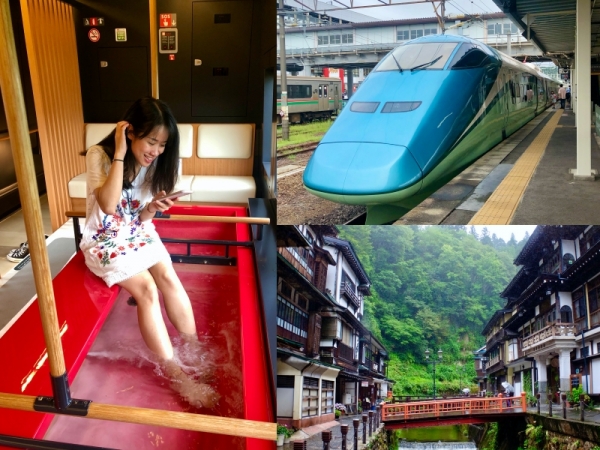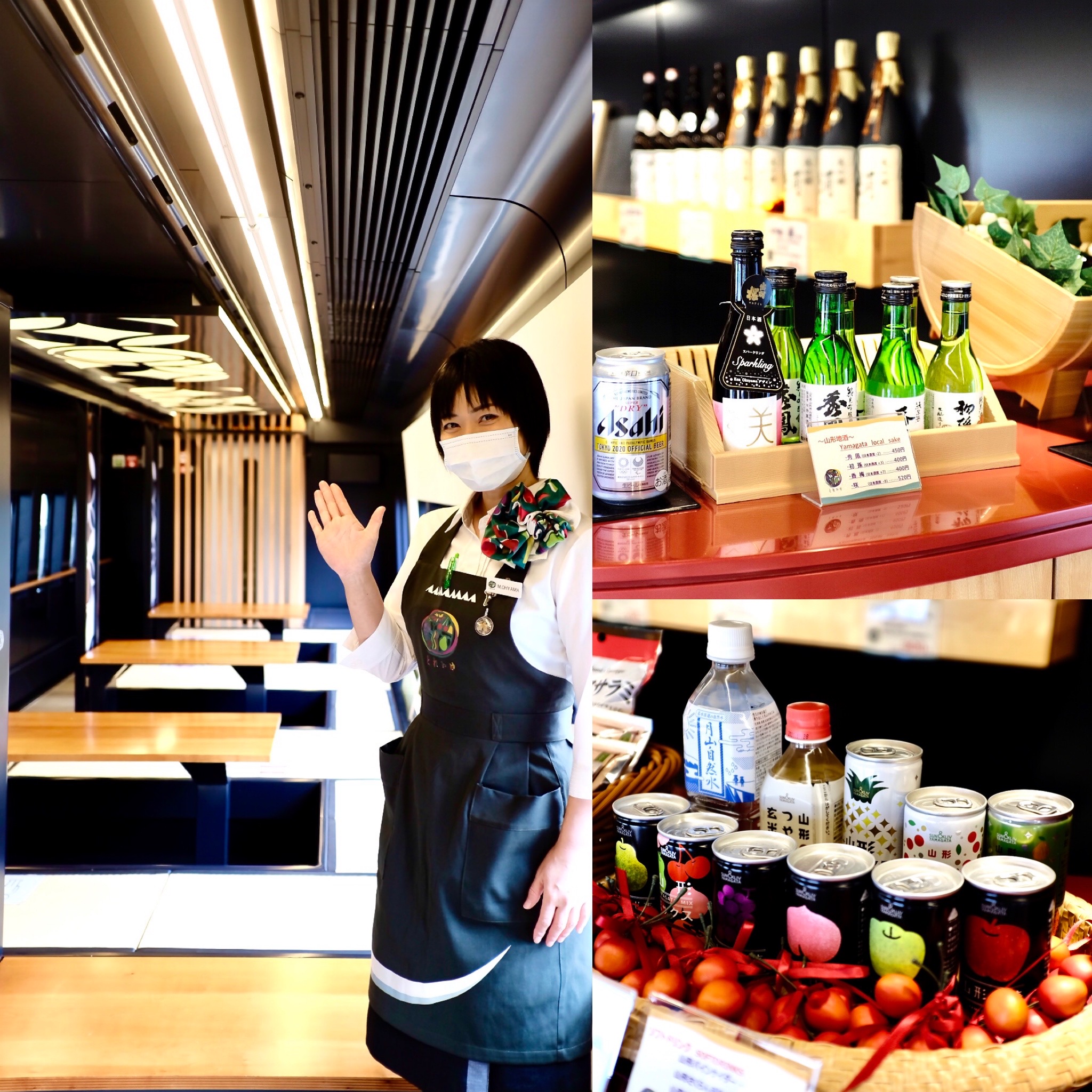
Referring to Japan, people often think of Mount Fuji, cherry blossoms, the bustling capital of Tokyo or the peaceful ancient capital of Kyoto with famous dishes such as Sushi, Wagu beef or rich ramen … However, another “specialty” that cannot be ignored when it comes to Japan is the “subway”, which is the high-speed Shinkansen train with a speed of hundreds of km / h, the Tokyo metro. bustling bustling with a frequency of 3 minutes per trip or trains run through many peaceful and peaceful countryside but there is only 1 trip a day. Whether accidentally or intentionally, most of the railways pass through many places with beautiful natural scenery, giving you many unforgettable emotions!

As a fan of the Japanese hot springs “onsen”, this time we decided to try to go from Fukushima to the Ginzan Onsen hot springs in Yamagata prefecture on a “special” train of the company’s Joyful Trains train system. JR East Railway: Toreiyu Tsubasa train, connecting two unique Japanese elements that I especially love, railway and hot springs. This is the only train with a mineral water bath (Ashiyu 足 湯) and is decorated more like an onsen resort than a regular bullet train, allowing visitors to experience a water foot bath. warm while relaxing while admiring the beautiful natural scenery of the Yamagata mountains. Its dramatically changing seasonal natural scenery is sure to make for a delightful ride on this train at different times of the year!

From Tokyo, it only takes about an hour and a half to get to the Shinkansen to get to Fukushima Station and you can catch the Toreiyu Tsubasa train. The Toreiyu Tsubasa trains operate on Saturdays, Sundays and public holidays. Foreign tourists can also use the JR East Pass to ride this train without having to purchase additional tickets (but please note that reservations are required). So if you intend to travel to Yamagata or Ginzan Onsen, do not miss out on this special train experience!

Running on the Yamagata Shinkansen Line connecting Fukushima Station and Shinjo Station, the Toreiyu Tsubasa train has many local features. The exterior of the ship is painted blue and green, representing the sky and land here, while the interior compartments are decorated in warm and vibrant colors. The train consists of 6 cars, from 11 to 14 are passenger cars, car 15 is a place for drinks and snacks (Yuagari Lounge), and foot baths are placed in car 16. Passenger carriage is decorated with cardboard Bright red, on ceilings and partitions featuring stylized designs of cherry, grapes and pears, are Yamagata’s famous fruits. The seats are very large, made from traditional Japanese tatami mats, and the blue seat cushion with motifs is a Yamagata specialty, can you guess what? These are cherry (Sakuranbo さ く ら ん ぼ), Shogi flag (将 棋 Japanese Chess), Hanagasa festival hat (花 笠 Yamagata biggest summer festival).

Can’t wait any longer, after settling, we head to car 16 to get a pre-ordered foot bath ticket, which costs 450 yen for 1 person for every 15 minute foot bath. Foot bath tickets can also be purchased directly at the train counter if space is available (can be viewed from the availability screen at each car). Ideally, once you get on the train, you should head straight to the foot bath to buy tickets, lest you run out of space.
You can arrive about 5 minutes in advance to wait for your turn. Before entering the foot bath, we were given a bag to store shoes, socks and a bag of small towels to clean your feet with a postcard for you to take home. Japanese service is number 1!

There are 2 red soaking tubs in the compartment, each tank allows up to 4 people to use it simultaneously. The tubs are arranged so that visitors can enjoy nature on both sides of the road along the Yamagata Shinkansen Line. The water temperature is also continuously adjusted to give everyone the best experience. Relaxing your feet, watching the beautiful natural scenery in the soft music on board is an unforgettable experience!

If the onsen areas, the Japanese often have a habit of enjoying cool drinks after soaking in hot water, you can also have a similar experience in car 15 – Yuagari Lounge on the Toreiyu Tsubasa train. The spacious lounge features tatami and special seats, a bar that serves sake and Yamagata’s wines and juices, snacks and bento exclusively for this train line. We decided to try apple and pear juice, the sweetness is natural !. Also if you have time, don’t forget to try the Domannaka local rice box lunch and the Yonezawa beef for lunch on board!

Ginzan Onsen

In addition to its rich natural products, Yamagata is also famous for its onsen hot springs, including Ginzan Onsen, Akayu Onsen or Tendo Onsen. During this trip, we decided to visit Ginzan Onsen, one of the most famous hot spring towns of Yamagata as well as in Japan.
From Oishida Station on the Yamagata Shinkansen Line, we take a bus to Ginzan Onsen, which takes about 40 minutes. This quaint small town in the middle of the majestic mountains of Yamagata offers a nostalgic atmosphere, separate from the bustling bustle of the city.

True to its name, Ginzan (Silver Mountain) is a place specializing in silver mining from more than 500 years ago. After miners at the time discovered many hot spring sources, it gradually became a popular resort destination and became famous after it was rebuilt in the Showa period. After the Yamagata railway was put into operation, Ginzan Onsen attracts many tourists from all over the world.

We went to Ginzan Onsen during the light rain, but it didn’t diminish our eagerness to visit this small town for the first time. Unlike the usual pictures of Ginzan Onsen in winter when the whole town is covered in snow, Ginzan Onsen in the summer brings a sense of the freshness of a resort town in the middle of the mountains. Wooden Japanese-style inns (Ryokan 旅館) are located along the two riverside road, connected by small bridges across the stream, just like the scene from the famous cartoon Sprited Away by Ghibli.
At night, this place becomes especially fanciful when the street lights are lit. The hot springs here are said to have small amounts of sulfur, which are known to beautify the skin and promote health. So don’t forget to try a natural hot spring bath while visiting Ginzan Onsen!

Walking along the town’s main street brings you to a small waterfall located behind the Ryokan inn, called Shirogane no Taki (白金 の 滝), part of a stream that flows through the town. Alternatively, if you head towards the Shirogane Koen Park located above the waterfall, you can visit the trails that lead to the silver mines, the workplace and the main source of income for locals for centuries. before.

On the way to Ginzan Onsen there are many fields of buckwheat stretching both sides of the road. Hence, when we got here, we decided to try the famous local soba noodles! What better way than to enjoy soba from a stream restaurant and take in the stunning views of Ginzan Onsen!

How to go
Operating mainly on Japanese weekends and holidays, Toreiyu Tsubasa runs a daily round trip, between JR Fukushima Station and JR Shinjō Station. See train timetable and timetable HERE.
You can take the Toreiyu Tsubasa train from JR Fukushima Station, about 90 minutes from JR Tokyo Station by bullet train. All seats on this special train require reservations, you can book HERE.
If you plan to visit the Tohoku area, check out the JR EAST PASS (Tohoku area) ticket, which is very affordable, allowing unlimited rides on JR East lines (including bullet trains !) on any 5 days within 14 days. Only 19,350 yen (about 4,185,000 VND) when purchased overseas, cheaper than the round trip ticket from Narita Airport to Fukushima (24,000 yen ~ about 5,190,000 VND), and not necessarily 5 consecutive days .
The Joyful Train Toreiyu Tsubasa can be traveled for free with the JR EAST PASS (Tohoku area) ticket. Without this ticket, a trip from Fukushima to Yamagata aboard the Toreiyu Tsubasa train costs around 3,450 yen (about 746,000 VND).